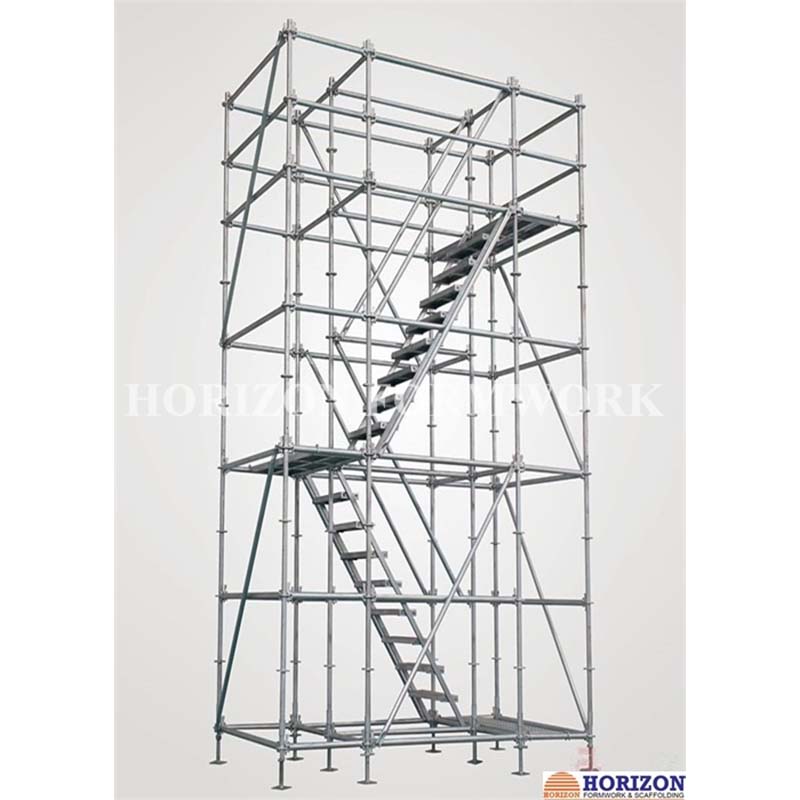Apr . 29, 2024 16:29 Back to list
What’s the Difference Between Scaffolding and Shoring? Scaffolding
Shoring and scaffolding are two separate systems used in the construction and engineering industries. It’s important to understand the differences between scaffolding and shoring for several reasons. The purpose of the system affects the safety factor, fall protection requirements, manufacturer guidelines, and other aspects of safe use.
Here’s a quick look at the difference between scaffolding and shoring to prevent any potential confusion.
Ringlock Scaffolding System
Definitions of Scaffolding and Shoring
According to the American National Standards Institute:
- Scaffolding is “a temporary elevated or suspended work unit and its supporting structure used for supporting worker(s) or materials, or both.”
- Shoring is “ The vertical supporting members in a formwork system.”
To elaborate, scaffolding is a temporary system built alongside a structure for the purpose of elevating workers, materials, and equipment so that construction, renovation, repair, or demolition work may be performed.
Shoring is a temporary system that supports a structure during construction, renovation, repair, or demolition work.
Primary Purpose: The Difference Between Scaffolding and Shoring
The easiest way to understand the difference between scaffolding and shoring is the main intent of the deck (platform). If the primary purpose of the deck is for workers to stand on it while performing tasks, it’s a scaffold; if the deck is mainly in place as part of the formwork that shapes and supports the structure being built or worked on, it’s shoring.
Again, it comes down to the primary purpose. Workers do at times stand on a shoring deck, which does not necessarily make it a scaffold. Also, the name of the equipment doesn’t dictate which system it’s a part of. For example, a scaffold frame can be used as a shoring component, and a shoring frame can be used as a scaffolding component. A shoring tower temporarily supporting planks that workers stand on while constructing a shoring system is scaffolding.
Common Types of Scaffolding
Some standard types of scaffolding include:
- Single scaffolding – Made up of standards, ledgers, putlogs, and other components, single scaffolding is often used during brick masonry work
- Double scaffolding – Commonly used in stone masonry, double scaffolding has a second scaffold row for support because of the difficulty of making holes in a stone wall for putlogs.
- Cantilever scaffolding – Single-frame and double-frame cantilever scaffolding have standards supported by needles running into the wall. It’s often used when the ground doesn’t provide adequate support or stability, and for upper levels of higher walls.
- Suspended scaffolding – Wire ropes or chains affixed to the roof of the structure suspend the platforms of this scaffolding, which can be raised and lowered. It’s often used when frequent upward and downward mobility are needed, as with certain repair work, painting, window washing, etc.
- Trestle scaffolding – These mobile scaffolds have platforms supported by movable ladders or tripods. They’re commonly used indoors and when frequent side-to-side mobility is needed during work.
- Steel scaffolding – Steel scaffolding, constructed from steel tubes attached by steel couplers or fittings, is quite strong and safe, and relatively efficient to assemble and dismantle.
- Patented scaffolding – This is a type of pre-assembled, height-adjustable scaffolding.

Common Types of Shoring
Some standard types of shoring include:
- H- or I-beam shoring – Commonly used to support excavations from 4 to 15 feet deep, steel H or I beams are placed into the ground by drilling or vibrating to support the piles.
- Secant pile shoring – A shoring wall is formed when there’s no room for open excavation with the use of interlocking primary and secondary piles.
- Contiguous pile shoring – This type of pile shoring is often used in clay soil and areas where water seepage is not a concern.
- Sheet pile shoring – Similar to H- or I-beam shoring, steel beams are driven into the ground with a vibro hammer to support the piles. Sheet pile shoring is often used for excavations around bodies of water.
- Diaphragm walls – These reinforced concrete shoring walls are commonly used for deeper excavations, like in the construction of basements, tunnels, etc.
-
Timber Beam H20 for Agricultural Buildings
NEWSJul.21,2025
-
Tie Rod Concrete Formwork for Bridge Construction
NEWSJul.21,2025
-
Table Formwork for Slab Edge Protection
NEWSJul.21,2025
-
Load Calculations for Wall Formwork System
NEWSJul.21,2025
-
Concrete Column Form Work Systems Productivity Tips
NEWSJul.21,2025
-
Beam Slab Formwork for Ribbed Slabs
NEWSJul.21,2025
